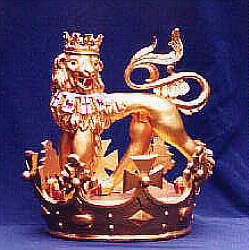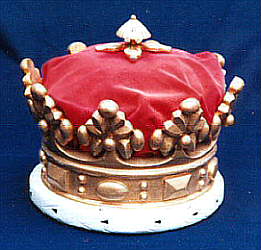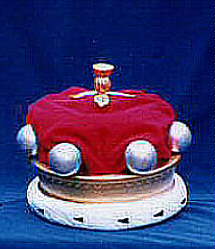
The Coronets of Members of the Royal Family and of the Peerage
Noel Cox
originally published in (1999) 22 The Double Tressure, the Journal of The Heraldry Society of Scotland 8-13
Unlike ordinary individuals, members of the royal family are not automatically entitled to arms, as the armorial bearings of the Sovereign are not hereditary as such, but are so-called arms of dominion or sovereignty.(1) Princely coronets also are as set by royal warrant, and are only granted to individuals, with the appropriate armorial ensigns.(2)
These coronets of rank are not merely found on armorial bearings, they are also actually worn, as part of the official costume of rank. Those members of the royal family who hold peerages wear their coronets with the appropriate peerage robes. Those who are not peers or peerages wear the appropriate coronet with suitable dress, such as uniform or court dress.
The coronets used with the arms of princes and princesses come in five forms, settled in 1662 by King Charles II. What might be termed type I has been used by the heir apparent since 9 February 1662. This consists of alternating four crosses-patée and four fleurs-de-lis, and an arch (only three crosses-patée and two fleurs-de-lis visible). This is currently only used by Charles Prince of Wales, and is the same circlet as the St Edward's Crown. It is erroneously styled the Prince of Wales's crown or coronet, erroneously because it appertains to the heir apparent regardless of any title they may hold.
Type II has been used for the sons and brothers of Sovereign, since 9 February 1662; and for the daughters and sisters of the Sovereign, since 19 November 1917. This is a coronet composed of four crosses-patée and four fleurs-de-lis alternately Or (only three crosses and two fleurs-de-lis visible). This is used by the Duke of York, the former Duchess of York, Prince Edward, Princess Royal, Princess Margaret, Princess Alice Duchess of Gloucester, and also by the Duke of Edinburgh.

The Coronet of HRH The Princess Royal (from a Garter Crest)
Type III, is used for the sons of the heir apparent, since 9 February 1662; and for the daughters of heir apparent, since 19 November 1917; and formerly for the sons and daughters of sons of the Sovereign, from 1662 to 1917. This has alternatively two strawberry leaves, two crosses-patée and four fleurs-de-lis (only two strawberry leaves, one cross and two fleurs-de-lis visible). This would be used by Prince William of Wales, and Prince Henry of Wales, with any armorial bearings granted to them. Till the time of Edward VII this was also used for the daughters of the Sovereign. Lady Patricia Ramsay retained it even though she renounced her royal style and title. It was worn by the Duke of Cumberland in 1902, and (presumably) by his sister, Princess Frederica.
Type IV, for the sons of sons and brothers of the Sovereign being dukes, has been used since 9 February 1662; and for the non-ducal sons and daughters of sons of the Sovereign (other than the heir) and of brothers of the Sovereign, since 19 November 1917. This has alternatively four crosses-patée and four strawberry leaves (only three crosses and two leaves visible). This is the style used by the Duke of Gloucester, the Duke of Kent, the Duchess of Gloucester, the Duchess of Kent, Prince Michael of Kent, Princess Michael of Kent, and Princess Alexandra of Kent. It is available for Princess Beatrice of York, Princess Eugenie of York.

The Coronet of HRH The Duke of Gloucester (from a Garter Crest)
Type V, for the sons and daughters of daughters of the Sovereign, being styled His or Her Highness, has been available since 19 November 1917. This has alternatively four fleurs-de-lis and four strawberry leaves (only three fleurs-de-lis and two leaves visible). It has not been in use by such people since the death of HH Princess Maud, born Lady Maud Duff (later HH the Countess of Southesk), in 1945. However, Princess Marie Louise, Hon Gerald Lascelles, did not wear robes or coronets, so this type may appertain to grandchildren throught daughters, who are peers or peeresses. It was granted 1917 to the Marchioness of Carisbrooke, and she actually wore it in 1937 and 1953. It was to have been lent to the Earl of Harewood 1953, but the Countess had to wear an ordinary countesses coronet as the marchioness attended herself, and there was only one coronet of this pattern.
The coronets of these princes and princesses are borne in place of any peerage coronet to which the holder may otherwise be entitled. Thus whether a prince is or is not a duke is not apparent from their armorial bearings, unless they are sons of sons and brothers of the Sovereign, not being dukes, granted arms prior to 1917. There are none such alive today.
The then Princess Elizabeth, and Princess Margaret Rose, wore robes at the coronation of King George VI in 1937. They were loosely based on the king's coronation robes, and had trains. Their coronets, or rather golden circlets, conformed with the patterns for daughters of the Sovereign, namely four crosses-patée and four fleurs-de-lis alternately.
The wearing of robes and coronets of rank is not uniquely British.(3) Nor are they confined to members of the royal family. Indeed, the robes worn by peers, both at coronations, and for formal sittings of the House of Lords, are well known.
As early as the end of the fourteenth century the greater peers wore distinctive robes of state.(4) One of the first recorded instance was the robe conferred upon John Beaufort Earl of Somerset, in 1397. These included robes, mantles, and hoods of scarlet furred with miniver.(5) The mantles were open on the right shoulder, and guarded with two, three or four bars of miniver in the form of short stripes high up on the shoulder. As with the gowns of judges, these were of the same general pattern as mediæval doctors after the latter had adopted scarlet in about 1340.
Dukes, marquesses, and earls received robes in the late fifteenth century, which resembled the almuce. Viscounts received robes in the sixteenth century. In the early seventeenth century the robes, or mantles, were of a circular cut, open from the shoulder on the right hand side, and with a short slit at the front of the neck. They might be fur-lined. From the centre front to the centre back, across the right shoulder, and side were miniver guards, consisting of bars of white fur with a gold lace edging above each bar.
By 1685, when barons at last received robes of estate, the robes peers wore at coronations were standardised as being of crimson velvet cloaks or robes of foot length, extending slightly to trail the ground at the back, open front, lined and edged miniver fur, and a hood, tippet or cape of miniver. Later rows or "doublets" of black ermine tails(6) replaced the bars of miniver on the right shoulder. The robes had sometimes varied to purple. The mantle was lined with white taffeta, with the mantle doubled from neck to below the elbow with ermine. By 1788 a white fur turn-down collar had been added to the ermine cape.
These robes were given at the investiture and not worn again except at coronations.
The coronet which is worn with the coronation robes, is now a silver-gilt circlet, has a crimson silk Genoa velvet lining, with a gold tassel and a band of ermine around the base, based on the old cap of estate,(7) which has been combined for over three hundred years. First conferred on kings and later on royal dukes, the cap of estate was conferred on John of Gaunt as Duke of Lancaster in 1362. It was later conferred on dukes, possibly encircled by a coronet. By the end of the fifteenth century it was given to marquesses.(8) The earls received it in 1546-7, viscounts (with plain fur rather than ermine) by King James I.(9) It was allowed to barons in 1661.
The original chaplet may well have been a wreath or garland, but became a gold circle, sometimes jewelled, often ornamented in the shape of flowers. The coronet proper appears in the fourteenth century, and the name itself from the late fifteenth century, first for earls and dukes. Marquesses had coronets from 1385, earls received a coronet in 1547, viscounts 1604 (although the evidence is conflicting(10)), and barons only in 1661.
The rank of the wearer is indicated by the form of the coronet, as it is shown by the pattern of the robes. Dukes coronets, which, unlike their lesser peers, are of silver gilt (originally gold), have eight strawberry leaves. Marquesses have four strawberry leaves and four silver balls(11) a little raised on points or spikes from the rim of the coronet. Earls have eight strawberry leaves, and eight silver balls a little raised on points from the rim of the coronet. Viscounts have sixteen silver balls on the rim of the coronet. Barons have six silver balls on the rim of the coronet.

A ducal coronet (from a Garter Crest)
To 1661 the circlet of earls and above were engraved, those of viscounts being plain. After 1661 barons had plain rims, and those of viscounts were engraved. In 1665 Scottish and Irish peers acquired the right to similar coronets. No real or artificial pearls or precious stones are permitted.(12)

A baronial coronet (from a Garter Crest)
Peeresses coronets are gold circlets, similar in form to those of peers, but considerably smaller. They are designed to sit on the top of the head. Girls and young women wear circlets rather than coronets, which encircle the head.
Investiture, or Coronation Robes, and their coronets, have only been worn at Coronations since the formal investiture was replaced by the informal practice of introducing peers in 1621. Since then the investiture of the Prince of Wales, revived in 1911, alone remains as a reminder of the old practices.
The regalia, or Honours of the Principality of Wales, traditionally comprised the coronet, ring, rod, and mantle, as for any peer of high degree. The Tudors added the sword, and the girdle. The golden rod of the dukes disappeared with the formal investiture ceremony, but appears in the investiture of the Prince of Wales. Since 1911 the National Museum of Wales, Cardiff has kept the Prince of Wales's Verge, Prince of Wales's Sword, Prince of Wales's Coronet, and Prince of Wales's Ring, all made in 1911. These were removed 1968 for the forthcoming investiture, and returned 1969 with the new Prince of Wales's Coronet.
The Prince of Wales's Coronet or chaplet (1911) is made to the ancient crown pattern. The design is by Sir William Goscombe John, RA, and it was made by Garrard and Company. As with the other 1911 items it used gold from Prince Edward Mine, near Trawsfyndydd, Gwynedd. Within an outline of four crosses-pattée run sprays of roses, and within outlines of four fleur-de-lis are daffodils. The gems are pearls and amethysts.
The 1969 Prince of Wales's Coronet is mounted with 12 emeralds and 75 diamonds. It weighs 3 lb (105 oz), and is of 24 carat gold, reinforced with iridium platinum. It was designed by Louis Osman, and made by David Mason. The design was approved January 1969. A copper mock-up was ready April 1969, and the final coronet was grown over a period of three days in an electroplating bath. The first version was flawed, and the golden sphere was given strength by being built around a resin ping-pong ball, silver-coated, placed in an electroplating vat of gold.
The final coronet was only ready ten days before the investiture. There is a single arch surmounted by a symbolically engraved orb featuring a Welsh dragon, the corn stooks of the Earl of Chester, Prince of Wales's Feathers, and the bezants of the Duchy of Cornwall. The four crosses pattée, and four fleurs-de-lis are of Welsh gold. The total cost was £3,600. It was the gift of the Goldsmiths and Silversmiths Company.
The Prince of Wales's crown or coronet of 1728 was made for Frederick Louis, used in 1729 when he took his place in the House of Lords, where it was placed in front of him on a cushion. It was last used in this fashion by King Edward VII. Made of gold, the crown weights approximately 1 lb 14 oz, and has a single arch which is said to have been taken from the coronation crown of Mary of Modena.
A silver-gilt crown was made 1901-1902 for George V when Prince of Wales, to attend the coronation of his father, King Edward VII, in 1902. It was used by the late Duke of Windsor for the coronation of King George V (and worn with the robes of a Knight of the Garter), and was sent to the Jewel House after his death in 1972. It was made by Garrard and Company, weighs 11.4 oz, and has a cap of estate of red velvet turned up with ermine.
(1) Licences may be granted by the Crown to use the royal arms, and they may be displayed in church to signify the royal supremacy; Re West Tarring Parish Church [1954] 2 All ER 591; [1954] 1 WLR 923n; Re St Paul, Battersea [1954] 2 All ER 595; [1954] 1 WLR 920.
(2) The armorial bearings which were or are hereafter assigned to a grandchild of a Sovereign become hereditary after a royal warrant of 24 February 1975 signed on HMY Britannia:
The Armorial Ensigns assigned by royal warrant to any grandchild of a Sovereign of these Realms (excepting the eldest son of the Prince of Wales) shall henceforth become heritable by the descendants of such grandchild with due and proper differences.
The "due and proper differences" must include different coronet.
(3) Although Swedish princes possess princely coronets, these are not now worn.
(4) In 1362 John of Gaunt, created Duke of Lancaster, received at his investiture a sword, a circlet or coronet of gold and precious stones, a cap of estate, and a golden rod.
(5) Miniver, or minever, is a white fur, originally mixed or variegated, used for lining and trimming.
(6) For a very long time past the original black-tipped tail of the ermine has been replaced by pieces of black fur cut out with a special steel punch.
(7) Now invariably worn beneath the coronet.
(8) Possibly on Robert de Vere, Marquess of Dublin (Edward IV).
(9) Though it has been said that this was done in 1550.
(10) See WH St John Hope, "The Cap of Maintenance" in LG Wykeham Legg, English Coronation Records (1902) appendix.
(11) "Pearls".
(12) Regulations for the coronation of 1727.